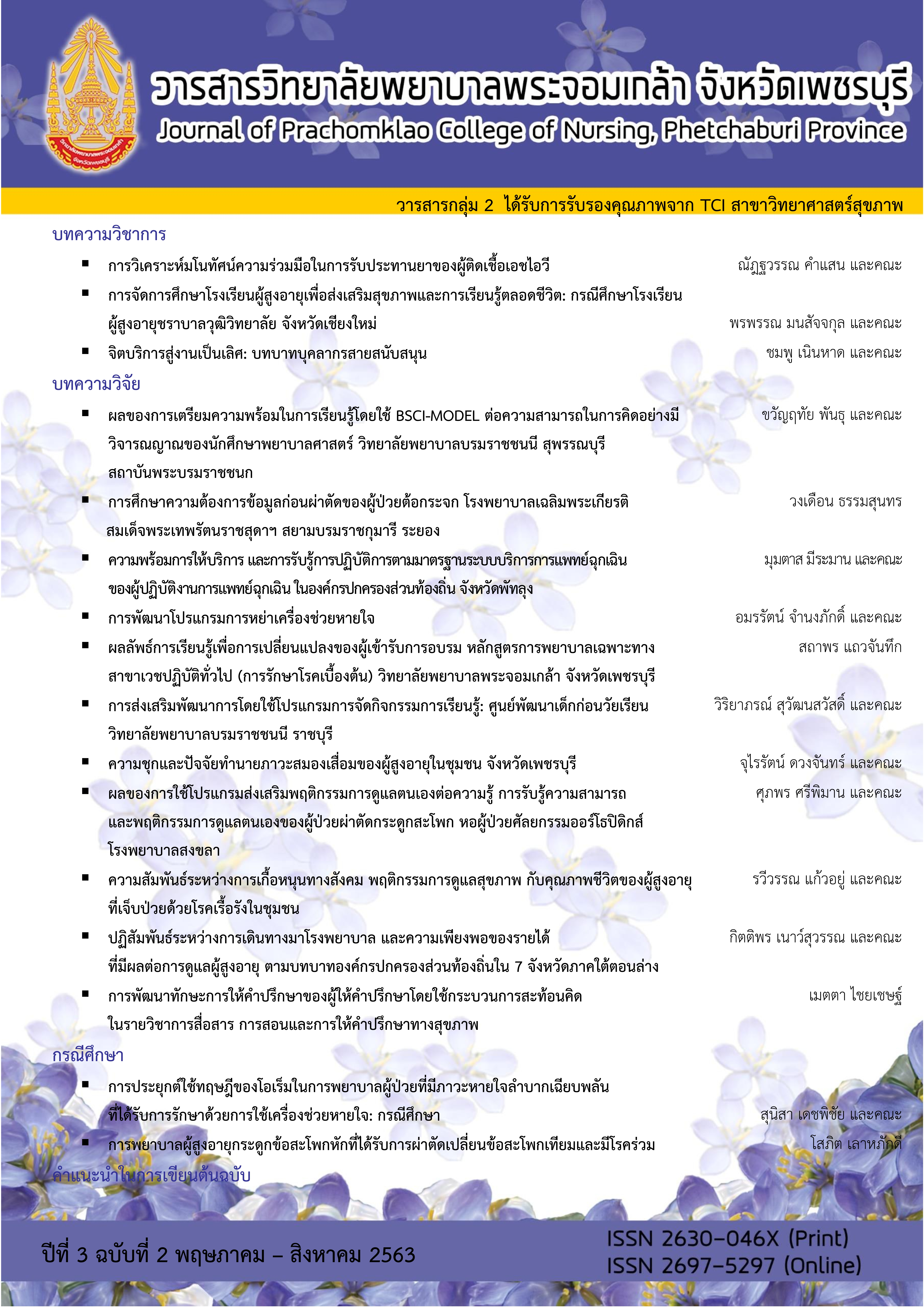การวิเคราะห์มโนทัศน์ความร่วมมือในการรับประทานยาของผู้ติดเชื้อเอชไอวี
Main Article Content
บทคัดย่อ
ความร่วมมือในการรับประทานยาของผู้ติดเชื้อเอชไอวีเป็นมโนทัศน์ที่น่าสนใจ ซึ่งหากผู้ติดเชื้อเอชไอวีขาดความร่วมมือในการรับประทานยาจะส่งผลให้เชื้อดื้อยาและอาการของโรครุนแรงขึ้น แต่ยังขาดความชัดเจนในวรรณกรรม โดยเฉพาะการดูแลผู้ติดเชื้อเอชไอวี บทความนี้ มีวัตถุประสงค์เพื่อวิเคราะห์มโนทัศน์ความร่วมมือในการรับประทานยาของผู้ติดเชื้อเอชไอวี และได้คำจำกัดความที่มีความชัดเจนยิ่งขึ้น ตลอดจนคุณลักษณะของมโนทัศน์ คำศัพท์และขอบเขตของมโนทัศน์ที่ชัดเจน โดยใช้วิธีการวิเคราะห์มโนทัศน์ของ Walker and Avant (2019) 8 ขั้นตอน ได้แก่ 1) การเลือกมโนทัศน์ 2) การกำหนดวัตถุประสงค์ของการวิเคราะห์มโนทัศน์ 3) การระบุการใช้มโนทัศน์ที่สามารถค้นหาได้ 4) การกำหนดคุณลักษณะของมโนทัศน์ 5) ระบุกรณีตัวอย่างที่สมบูรณ์แบบ 6) การระบุกรณีศึกษา 7) การระบุสิ่งที่มาก่อนและผลที่เกิดขึ้น และ 8) กำหนดเกณฑ์ชี้วัด ตามลำดับ
ผลการวิเคราะห์ได้คำจำกัดความของมโนทัศน์ความร่วมมือในการรับประทานยา และคุณลักษณะที่กำหนดของมโนทัศน์ คือ 1) การรู้จักยาและเห็นด้วยกับการรับประทานยาและประโยชน์ของการรักษารวมถึงคำแนะนำจากบุคลากรทางสุขภาพ 2) การสื่อสารต่อรองเรื่องการรักษาและตัดสินใจร่วมมือในการรับประทานยาหรือคำแนะนำอื่นๆ ภายใต้ข้อจำกัดหรือบริบทของตนเอง และ 3) การมีส่วนร่วมในแผนการรักษาอย่างต่อเนื่องและจริงจัง รวมถึงการประเมินผลข้างเคียงจากการรักษา ควรมีการนำมโนทัศน์นี้ ไปใช้ในการประเมินคุณภาพการพยาบาล และพัฒนาเครื่องมือในการวิจัยทางการพยาบาล
Downloads
Article Details
เนื้อหาและข้อมูลที่เผยแพร่ในวารสารวิทยาลัยพยาบาลพระจอมเกล้า จังหวัดเพชรบุรี ถือเป็นข้อคิดเห็นและความรับผิดชอบของผู้นิพนธ์บทความโดยตรง บทความ เนื้อหา ข้อมูล รูปภาพ ฯลฯ ที่ได้รับการเผยแพร่ในวารสารนี้ ถือเป็นลิขสิทธิ์ของวารสารฯ หากบุคคลหรือหน่วยงานใดต้องการนำทั้งหมดหรือส่วนหนึ่งส่วนใดไปเผยแพร่หรือเพื่อกระทำการใด ๆ จะต้องอ้างอิงวิทยาลัยพยาบาลพระจอมเกล้า จังหวัดเพชรบุรี ทุกครั้ง
เอกสารอ้างอิง
นันทลักษณ์ สถาพรนานนท์. (2555). ความไม่ร่วมมือในการใช้ยา. วารสารไทยไภษัชยนิพนธ์ (ฉบับการศึกษาต่อเนื่องทางเภสัชศาสตร์) มศก., 7, 23-36.
นิธิพัฒน์ เจียรกุล. (2555). จริยธรรมทางการแพทย์ในยุคปัจจุบัน. วารสารคลินิก, 28(5), 341-343.
สำนักโรคเอดส์ วัณโรคและโรคติดต่อทางเพศสัมพันธ์ กระทรวงสาธารณสุข (2560). แนวทางการตรวจรักษาและป้องกันการติดเชื้อเอชไอวี ประเทศไทย. กรุงเทพฯ: โรงพิมพ์สำนักงานพระพุทธศาสนาแห่งชาติ.
Agala, C. B., Fried, B. J., Thomas, J. C., Reynolds, H. W., Lich, K. H., Whetten, K.,… Morrissey, J. P. (2020). Reliability, validity and measurement invariance of the Simplified Medication Adherence Questionnaire (SMAQ) among HIV-positive women in Ethiopia: A quasi-experimental study. BMC Public Health, 20(1), 567. doi: 10.1186/s12889-020-08585-w
Aronson, J. K. (2007). Compliance, concordance, adherence. British Journal of Clinical Pharmacology, 63(4), 383-384. doi: 10.1111/j.1365-2125.2007.02893.
Chesney, M. A., Ickovics, J. R., Chambers, D. B., Gifford, A. L., Neidig, J., Zwickl, B., & Wu, A. W. (2000). Self-reported adherence to antiretroviral medications among participants in HIV clinical trials: The AACTG adherence instruments. Patient care committee & adherence working group of the outcomes committee of the adult AIDS clinical trials group (AACTG). AIDS Care, 12(3), 255–266. doi: 10.1080/0954012005004291
Haynes, R. B., Taylor, D. W., & Sackett, D. L. (1979). Compliance in health care. Baltimore, MD: The Johns Hopkins University Press.
Huang, L., Li, L., Zhang, Y., Li, H., Li, X., & Wang, H. (2013). Self-efficacy, medication adherence, and quality of life among people living with HIV in Hunan province of China: A questionnaire survey. Journal of the Association of Nurses in AIDS Care, 24(2), 145–153. doi: 10.1016/j.jana.2012.04.006
Iacob, S. A., Iacob, D. G., & Jugulete, G. (2017). Improving the adherence to antiretroviral therapy, a difficult but essential task for a successful HIV treatment-clinical points of view and practical considerations. Frontiers in Pharmacology, 8, e831. doi: 10.3389/fphar.2017.00831
Kaufman, G., & Birks, Y. (2009). Strategies to improve patients’ adherence to medication. Nursing Standard, 23(49), 51-57.
Mannheimer, S., Friedland, G., Matts, J., Child, C., & Chesney, M. (2002) The consistency of adherence to antiretroviral therapy predicts biologic outcomes for human immunodeficiency virus-infected persons in clinical trials. Clinical Infectious Diseases, 34(8), 1115-1121. doi:10.1086/339074
Parienti, J. J., Verdon, R., Bazin, C., Bouvet, E., Massari, V., & Larouzé, B. (2001). The pills identification test: A tool to assess adherence to antiretroviral therapy. JAMA, 285(4), 412. doi: 10.1001/jama.285.4.412
Pinheiro, C. A., de-Carvalho-Leite, J. C., Drachler, M. L., & Silveira, V. L., (2002). Factors associated with adherence to antiretroviral therapy in HIV/AIDS patients: a cross-sectional study in Southern Brazil. Brazilian Journal of Medical and Biological Research, 35(10), 1173–1181. doi: 10.1590/s0100-879x2002001000010
Rodgers, B. L., Jacelon, C. S., & Knafl, K. A. (2018). Concept analysis and the advance of nursing knowledge: State of the science. Journal of Nursing Scholarship, 50(4), 451-459. doi: 10.1111/jnu.12386.
Rongkavilit, C., Naar-King, S., Kaljee, L. M., Panthong, A., Koken, J. A., Bunupuradah, T., & Parsons, J. T. (2010). Applying the information-motivation-behavioral skills model in medication adherence among Thai youth living with HIV: A qualitative study. AIDS Patient Care and STDs, 24(12), 787–794. doi: 10.1089/apc.2010.0069
Walker, L. O., & Avant, K. C. (2019). Strategies for theory construction in nursing (6th ed.). New York: Pearson.
Webel A. R. (2010). Testing a peer-based symptom management intervention for women living with HIV/AIDS. AIDS Care, 22(9), 1029-1040. doi: 10.1080/09540120903214389.
Wickersham, K. E., Sereika, S. M., Kang, H. J., Tamres, L. K., & Erlen, J. A. (2018). Use of a self-report medication adherence scale for measuring adherence to antiretroviral therapy in patients with HIV/AIDS. Journal of Nursing Measurement, 26(2), e72–88. doi: 10.1891/1061-3749.26.2.E72
World Health Organization (2003). Adherence to long-term therapies: Evidence for action. Geneva: World Health Organization.
Yu, Y., Luo, D., Chen, X., Huang, Z., Wang, M., & Xiao, S. (2018). Medication adherence to antiretroviral therapy among newly treated people living with HIV. BMC Public Health, 18(1), e825. doi: 10.1186/s12889-018-5731-z


